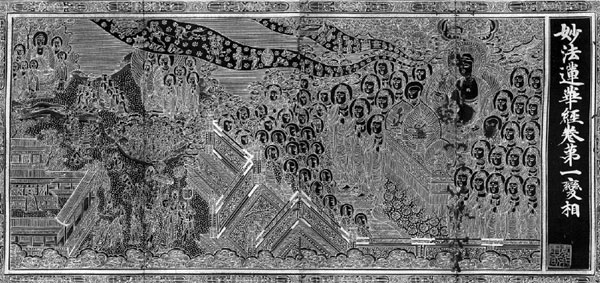Classical Chinese art on the block
Works from several centuries past will be part of Sotheby's semiannual offering of Chinese art, Lin Qi reports.
Eleven classical Chinese paintings and calligraphic pieces, collected by a private library in Zhejiang province over a period from the late Qing Dynasty (1644-1911) to the time of the Republic of China (1911-49), will go under the hammer in Hong Kong on May 30.
A highlight is The Lotus Sutra, a calligraphic set of seven albums of Buddhism inscriptions written in gold on blue paper by an anonymous artist of the Yuan Dynasty (1271-1368).
|
The upcoming Sotheby's auction in Hong Kong features some of the country's rarest treasures, such as The Lotus Sutra (above and bottom) from the Yuan Dynasty (1271-1368) and an album of landscape paintings and calligraphy (below) by Shitao from the Qing Dynasty (1644-1911). Photos Provided to China Daily |
The Mi Yun Hall library was built on an accumulation of books by Jiang Ruzao (1876-1954), an entrepreneur in Huzhou, Zhejiang province.
The collection boasts rare and quality titles of the Song (960-1279) and Yuan dynasties.
His son Jiang Zuyi (1902-73) extended the spectrum of the family collection to classical Chinese paintings, calligraphic pieces and other antique works of art.
Jiang Zuyi remained an art connoisseur after moving to Taiwan in the 1940s, together with his family's cultural specimens.
Items from the Jiang family's collection to be auctioned by Sotheby's Hong Kong also include Letters, four calligraphic scrolls of the Song Dynasty government official Zhang Wenjing.
They not only provide reference to the development of Chinese calligraphy but also Song politics.
An album of 10 leaves of landscape paintings and calligraphy by early Qing painter Shitao, the pseudonym of Zhu Ruoji, will also appear in the salesroom.
Measuring only 20 by 15 centimeters for each leaf, the works reveal his impressionistic brushstrokes and masterly use of space to present a feeling of solitude.
Sotheby's launched a sale devoted to classical Chinese painting as part of its autumn sales in Hong Kong in October. Starting with the upcoming sale, the auctioneer will hold two auctions of classical Chinese paintings every year.
The practice follows its launch of classical Chinese paintings sales in New York in 2011, which generated some high prices. A calligraphic album of Ming Dynasty Buddhist sutras sold for $14 million to Shanghai collector Liu Yiqian in 2015.
Steven Zuo, head of Sotheby's classical Chinese paintings department in Asia, tells China Daily that the salesrooms in both New York and Hong Kong attract global bidders, while the Hong Kong auctions highlight the appetite of Asian buyers.
The category of classical Chinese paintings, normally referring to works executed before the 20th century, has performed steadily in the market, while modern ink art has dropped in value amid a market reshuffle since 2014.
A calligraphic letter by Song politician Zeng Gong fetched 207 million yuan ($31.85 million) at a Beijing auction on May 15.
The most expensive classical Chinese ink art sold at auction so far is Di Zhu Ming, a calligraphic hand scroll by Song master Huang Tingjian that grossed 436.8 million yuan in Beijing in 2010.
Zuo says classical paintings, as an important bearer of Chinese cultural traditions, have a mature, stable collecting group. Generally speaking, this is less affected by economic changes than other categories.
The classical Chinese art market doesn't create a lot of bubbles like modern and contemporary art because its "higher threshold" turns away speculators seeking short-term profits, says Tu Xin, a Beijing-based art dealer.
"When you want to know whether a Zhang Daqian piece is genuine or counterfeit, quality or ordinary, you have a stack of his other works for reference," she says, adding that for classical art, few examples are available today, making it difficult for people to judge right from wrong, excellence from a bunch of commonplace works.
"To collect classical pieces, one has to invest much time and energy to increase knowledge and be discerning. A devoted collector is sensible when bidding at auction, and he is unlikely to resell his collections for instant profit."
Contact the writer at linqi@chinadaily.com.cn
(China Daily 05/24/2016 page20)



















